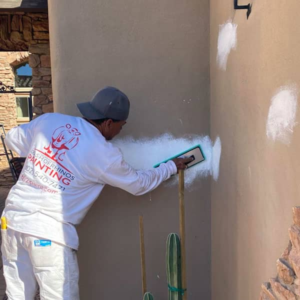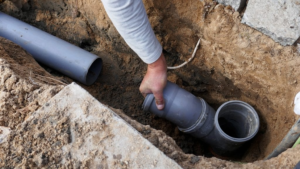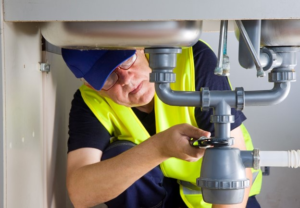Stucco Repair is a great DIY project for homeowners with basic handy skills and experience with home improvements. However, having a stucco expert repair major damage and issues is best.
Regular inspections can prevent underlying problems from worsening. For example, a damp-looking stucco can indicate that the gutters are leaking or that the sprinkler system is spraying water onto the wall. Click here to Learn More.

Stucco is a popular material for both exterior and interior walls, prized for its durability and beauty. But like any material that has been exposed to the elements, stucco is vulnerable to cracking and other damage over time. Regular inspections and professional repairs can help ensure that your home’s exterior and interior stucco walls remain in excellent condition.
Cracks in stucco are usually a result of structural movement, but they can also be caused by improper installation, moisture intrusion, or sheathing issues. Cracks that appear suddenly or are wider than 1/16” are more serious and should be repaired by a qualified professional as soon as possible to prevent further damage.
Hairline cracks (less than 1/16” wide) can be filled and repaired with a variety of commercially available stucco patching compounds. Cracks that are wider than this will need to be widened using a cold chisel and hammer before patching. It’s also important to consider the pattern and location of the cracks when deciding whether or not to repair them. Diagonal or stair-step patterns often indicate structural movement, while horizontal and vertical cracks are usually related to expansion and settlement.
For smaller cracks, it’s best to simply paint over them. Various caulks and cement can be used for this purpose, but it’s essential to know what type of stucco was originally installed on the building before choosing a repair method. Generally, pure lime – either dry hydrated or mature fat lime – was used in older homes, and it’s important to use the same type of material for any subsequent repair work to maintain both historical continuity and structural compatibility.
If you are repairing larger cracks, it’s helpful to have a good quality caulking that’s specifically designed for use with stucco. Quikrete makes a product called Alex Plus that is a high-performance acrylic latex caulk with silicone additives. It’s easy to use, cleans up with water and is ready to be painted in about half an hour.
Cracks that reappear after being patched are usually indicative of sheathing or substrate movement and should be addressed by a licensed professional. Cracks that occur around windows, doors or corners are especially problematic because they can signal a serious structural problem. If the cracks are accompanied by drywall separation, a professional should be hired immediately to assess and repair the structural integrity of the building.
Holes
Stucco, a type of plaster that is made from cement, sand and water, is a highly durable exterior finish. Unfortunately, it isn’t immune to damage and holes can form in the surface of the stucco for a number of reasons. These can include weather conditions and physical impacts. Although these imperfections can be unsightly, they don’t necessarily signal any structural issues and can be easily repaired with a bit of time and effort.
Before beginning the repair process, it is important to assess the extent of the damage and understand what caused the hole. This will help you determine the right approach to take and will ultimately ensure a high quality and long lasting repair. To begin, make sure that the area surrounding the hole is clear of any furniture, plants or other decorations that may hinder access or get damaged during the repair process. Use a wire brush to gently scrub the area, and remove any loose or flaking stucco. If there is any old, crumbling stucco around the hole, carefully chip away at it with a hammer and chisel. Be careful not to damage the wood or lath underneath.
Once the damaged areas are clear, apply a layer of specialized stucco patching compound to the interior wall. Using a putty knife or trowel, spread this material evenly until it is fully covering the hole. If necessary, add a layer of stucco wire mesh to the top of the compound to reinforce it and hold it in place. Once the first layer is dry, allow it to cure for 24 hours before applying a second layer of patching compound. Once this is dried, paint the repaired area with a stucco coating that matches the color of the existing stucco.
Though small cracks and holes can be repaired with ease, extensive damage or widespread damage should always be handled by a professional. A professional can ensure that the repairs are done correctly and that they will last, and they can also help you to find a product that better matches your existing stucco for an even more seamless appearance.
Stains
Stains and discoloration can be caused by many different things, and a thorough search of the entire stucco surface is essential. If not addressed, these stains can lead to water damage within the walls and create further problems such as mold and mildew.
Before cleaning your stucco, check that the wall is free of cracks and chips. If you notice any hairline cracks, they are easy to repair with a caulking designed for stucco, found at most home improvement stores. Once these minor repairs are made, wash the stucco to remove dust and debris.
A good quality scrub brush will help you remove stubborn stains. Be sure to use a soft bristle, as hard brushes can cause damage to the stucco material. Scrub the staining area thoroughly with the brush, either by hand or with a power washer, using a light to medium pressure. After scrubbing, rinse the wall again with water. This will clean off the detergent solution and, when done correctly, will also flush away any pollutants left on the wall as well.
Mildew stains are common on stucco and look like black streaks or blotches on the wall. Mildew stains usually appear in places where moisture accumulates, such as under eaves or near downspouts. Algae stains, which are green in color, can also be seen on stucco and are an indicator of moisture affecting the structure underneath.
In order to prevent stains, it is best to keep your stucco dry by keeping it shaded and using regular washing and rinsing. In addition, you can apply an acrylic caulk that closely matches the color of your stucco to prevent moisture from penetrating through the cracks and into the inside of the wall. It is also important to check the weather conditions before working on your stucco; freezing temperatures can ruin freshly applied stucco, while hot and dry weather will cause it to dry too quickly and affect its durability. If you need to work on your stucco in harsh weather, make sure to cover the area with a plastic sheet to keep it moist and protected.
Water Damage
Stucco is a great material to use around windows and doors because it’s water resistant. However, if you have trees or flower beds right up against the stucco that are constantly being saturated by rain or the sprinklers aren’t properly calibrated, water could infiltrate the walls and cause problems. Leaks around the windows and doorways are common, but it’s also a good idea to check for other signs of water infiltration, such as dark staining or soft or crumbling texture.
When it comes to repairing stucco that is mildly damaged, you can usually fix it on your own. Start by removing the affected area of the wall, much like you would when dealing with a damaged piece of drywall or rotted wood. Then, mix a stucco batch that matches the current exterior and patch it over the hole. It’s important to apply three coats, allowing the stucco time to cure between each application.
More severe damage requires the assistance of a professional. IICRC-certified water-damage remediation experts can determine the extent of the problem, provide guidance regarding your options, and perform professional water damage restoration services.
The main signs of moisture damage in stucco are cracking and staining. It’s crucial to take these issues seriously, as they can lead to mold and structural damage if left unchecked.
If you notice these signs, contact a stucco expert immediately to determine the root cause and repair it before it worsens. If you don’t address the issue quickly, it may eventually delaminate from the wall and require complete removal.
While some homeowners will deal with the surface of the mold and think they’ve taken care of the problem, it’s often just a symptom of deeper moisture issues. Trying to patch over it will only make the situation worse long-term. If you need help removing the damaged stucco and fixing the underlying issues, get in touch with an IICRC-certified mold removal professional. They can offer advice on the best course of action and ensure that the mold is fully eradicated. They can also help with a full stucco repair to protect your home from future problems.

